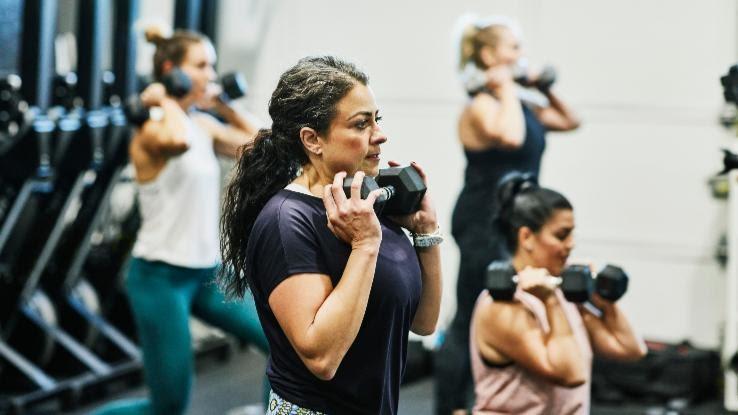What Is Physical Fitness & What Does Physically Fit Mean?

What comes to mind when you hear the term “physical fitness?” For some people, it’s images of bodybuilders lifting heavy weights, while others may picture a marathon runner crossing the finish line. Even the dictionary gives a fairly limited definition when it describes physical fitness as “good health and strength achieved through exercise.”
But these days, many professionals are taking things a step further to include mental and emotional health in their overall definition of what physical fitness really means. Here we’ll take a deeper look and explore the various aspects of what it means to be physically fit.
5 Components of Health-Related Fitness
According to the fitness manual utilized by the American College of Sports Medicine (ACSM), bodily fitness is not as clear-cut as some may think. The ACSM evaluates five distinct components to assess a person’s overall level of physical health. These include:

Body composition
Body composition doesn’t necessarily mean that you have to have large muscles. It’s actually measured by a person’s fat-to-muscle ratio. A physically fit person has a maximum ratio of lean mass over body fat.
Muscular strength
This measures a person’s strength to determine how well their body is or isn’t able to keep up with the physical demands it’s subjected to.
Muscular endurance
Endurance is also a large consideration when determining overall fitness. It’s a measure of how long your muscles are able to perform contractions for an extended period of time. For instance, even though two people might be able to lift the same amount of weight, one may be able to continually lift it more times than the other.
Cardiovascular fitness
As many athletes can tell you, strength alone doesn’t mean much without good heart health. Cardiovascular fitness measures the health of the heart and lungs and their ability to supply your body’s tissues with the needed amount of oxygen and nutrients while removing wastes.
Flexibility
Though it’s often overlooked, flexibility is also an important component of physical health. Flexibility measures how well your body’s joints are able to move in a way that utilizes their full range of motion.
Identifying the Characteristics of a Physically Healthy Person
So what does a physically healthy person look like? Contrary to popular belief, being physically healthy involves a lot more than just spending a great deal of time at the gym every week. While physical health does involve getting a reasonable amount of exercise, being physically healthy also involves proper nutrition and self-care.

Consumers for Health Choice points out that “The characteristics of a physically healthy person include a large spectrum of numbers, behaviors and even looks that a person can have.” Some of the things to consider when evaluating a person’s level of physical health include:
Healthy weight and size
Maintaining a healthy weight is important, and you also want to consume the proper nutrients your body needs. Ideal weight is often calculated by factors including age, gender and height.
Healthy skin, eyes and hair
Proper grooming habits can go a long way towards making sure your hair and skin are in good condition. Something as simple as making sure you maintain proper posture can even factor into your overall health. As far as eyes go, while you can’t necessarily control things like your eyesight, eyes that are swollen, red, watering or dilated can be signs of health problems.
Blood and respiratory health
Blood health can cover everything from maintaining a low resting heart rate and normal blood pressure to making sure your blood glucose levels are within normal range. As far as respiratory health is concerned, there’s a reason that doctors always carry around stethoscopes. Keeping your lungs healthy is an important part of making sure your body gets the oxygen it needs.
Proper care for disease
Diseases of all types can impact your overall health in addition to any specific bodily systems they affect. That’s why it’s not only important to live a healthy lifestyle but also to get checked regularly for health conditions you may be at risk of developing.
What Does It Mean to Be Physically Fit?
MIT Medical explains that “Physical fitness involves the performance of the heart and lungs and the muscles of the body. And, since what we do with our bodies also affects what we can do with our minds, fitness influences to some degree qualities such as mental alertness and emotional stability.”

It’s interesting to note that many experts are now linking mental, emotional and even spiritual health more closely with physical fitness. Even the World Health Organization states that “health is a state of complete physical, mental and social well-being and not merely the absence of disease or infirmity.”
While a positive outlook and attitude aren’t necessarily enough to ensure a healthy body, they definitely contribute to forming habits that can improve your overall health. Such habits might include:
- Maintaining a balanced, healthy diet and avoiding both overeating and undereating
- Getting enough sleep every night
- Drinking plenty of water
- Maintaining an exercise routine and avoiding a sedentary lifestyle
- Avoiding overindulging in caffeine, alcohol and other potentially harmful substances
- Getting treatment for addictions of any kind
Examples of Physical Fitness
While some of these habits are pretty straightforward, others tend to raise questions. For example, how often should you exercise in order to get or stay physically fit? According to the Mayo Clinic, you should aim to get at least 30 minutes of moderate physical activity every day. Keep in mind, however, that physical activity doesn’t necessarily equate to working out. If you’re on your feet all day at work, you may well get at least half an hour of moderate activity automatically.

If you want to lose or maintain your weight or adopt a workout regimen, start with two to three workout sessions a week and work your way up to five. Aim to include each of the following aspects in your weekly workout routine:
- Cardio exercises
- Strength training
- Core work
- Stretching
Why Is Physical Fitness Important?
Staying physically fit has a wide range of both short- and long-term benefits. The CDC notes that physical activity can help improve mental health and decrease the risk of depression, anxiety and insomnia. It also gives you a higher quality of life by keeping your bones, joints and muscles healthy enough to ensure that you’re able to engage in a typical range of activities without getting tired.

Physical fitness is just as, or perhaps even more, important to maintain as we age. Physically healthy people have a lower risk of developing diseases such as cardiovascular disease, Type 2 diabetes and even some cancers. Exercise and fitness also play important roles in helping older adults maintain bone density and the range of motion they need to continue living independently.
Not only does physical fitness help you live longer, but it can also help you enjoy life to the fullest. By making sure that your body stays healthy, you’ll be able to benefit from the highest possible quality of life now and in the future.





